Email marketing is special. You can also breathe easier knowing you’re part of an elite group — “the in-crowd.” They’ve agreed to let you in.
But this is just the first step. How can you engage and convert your subscribers? How do you make your words resonate with the reader? How do you replicate this across all email marketing campaigns?
The answer lies in your email writing style.
Let’s take a closer look at how to develop your email writing style. We’ll also take a look at five examples from real SaaS brands.
Don’t wait for the muse. Apply this step-by-step method to write high-performing email campaigns in hours, not weeks.
Step 1. Consider your product, audience, and email marketing goals
What is your product?
What kind of SaaS product do you offer? What does it do? What value does it promise? What’s your value statement?
Again, answer thoroughly.
Then sum up responses into key phrases like:
- Product offering: Calendar tool
- What it does: Help project managers plan timelines
- The promise of your product: High productivity, ease of use, stress relief, no information silos, accountability
- Value statement: We help project managers shave 20 hours off their workweek
Who’s your audience?
Who’s your SaaS product for? What are their core needs? What are their pain points? How can you help them better than the competition?
Sum up your answers into key points, like:
- Who the product is for: Project managers and project assistants
- The users’ core needs: Milestone mapping, project timeline strategy, timeline planning
- Users’ pain points: Tools without templates, tools that don’t offer 24/7 support, system lagging issues
- How we can help them be better: Our tool is the only one of its kind that supports project timeline strategy
Save all the keywords you’ve jotted down. We’ll refer to them again in step four.
What are your own email marketing goals?
Why did you start an email list in the first place? What are your company goals? What do you hope to achieve with your email campaigns?
Answer these questions thoroughly.
Then, review your answers and sum them up into key phrases like:
- To increase our lead list
- To have an ongoing lead nurturing channel
- To use as a promotional tool
- To better understand our audience
Step 2. Analyze your high-converting emails for writing style patterns
In step two, dedicate time to carefully analyze your past email marketing efforts.
What are your best-performing campaigns?
Which email campaigns have seen the most conversions? What writing style similarities do they share? What tone similarities do they have in common? Do they have similar formatting structures?
Jot down all of the patterns you notice.
For instance, maybe they:
- Include bullet lists with actionable tips
- Share a light-hearted, conversational writing tone
- Highlight social proof
- Have value-driven images that break up large walls of text
What are your worst-performing campaigns?
What writing style similarities do they share? What tone similarities do they have in common? Do they have similar formatting structures?
For instance, maybe they:
- Lack value
- Don’t speak directly to the target reader
- Have typos and grammatical errors
- Share a formal writing tone
Once you’ve reviewed your best and worst campaigns, create a dos and don’ts cheat sheet. You will use it in future email campaigns.
Here’s an example.
Dos and don’ts email writing cheat sheet
- Don’t write emails that lack clear value. — Do include plenty of actionable tips.
- Don’t crowd your emails with too much text. — Do use bullet lists and images to break up large walls of text.
- Don’t speak in a formal writing tone. — Do share insights light-heartedly and conversationally.
Save this cheat sheet for later — you’ll need it again in step four.
Step 3. Test several options for tone and style
What style and tone does your audience identify with? Do they gravitate toward actionable and informative? Conversational and witty? Positive and value-driven?
You’ll never know if you don’t test multiple options.

Take a look at your brand keyword list from step one, and your dos and don’ts email writing cheat sheet from step two, then test three tones and styles that align with both.
For instance, if your keywords and cheat sheet highlight words that focus mostly on productivity and scheduling, then you might want to try:
- Helpful (value-driven style)
- Informative (journalism style)
- Pointed (straightforward style)
You can speed up testing by using sales automation tools for your sales outbound strategy and an automated A/B email testing tool.
Whatever you do, never set up A/B testing campaigns without a follow-up plan in place.
Create a performance checklist to help you spot the tones and styles that resonated most. Then finalize your tone and style choices.
Here’s an example:
A/B Testing Performance Checklist
- The test campaigns that converted best include: _______, _______, _______.
- Key similarities these campaigns shared include: _______, _______, _______.
- The test campaigns with the lowest conversion rates include: _______, _______, _______.
- Key similarities these campaigns shared include: _______, _______, _______.
- Top performance metrics our best campaigns met and why: _______, _______, _______. ______________________________________.
- Top performance metrics our worst campaigns failed to meet and why: _______, _______, _______. ______________________________________.
- According to our best A/B testing campaigns, our audience resonates with the following tone and style choices: _______, _______.
- According to our worst A/B testing campaigns, our audience resonates least with the following tone and style choices: _______, _______.
- *Based on the results from our tests, our final tone and style choices include: _______, _______.
Don’t wait for the muse. Apply this step-by-step method to write high-performing email campaigns in hours, not weeks.
Step 4. Create a style guide
Use your materials from the previous steps to create an aligned style guide.
You’ll use your style guide to inform your email writing style and all of your email content moving forward.
A style guide is also an invaluable resource to have on hand when creating content for your SaaS marketing blog — so take your time setting it up.
Here’s what to include in your style guide.
Style Guide Template
Company introduction
- Who you are
- What you do
- What you offer (i.e., products, services, experiences)
- Your value proposition
Target audience
- Who you serve
- Buyer persona details
- Common audience pain points and how you solve them
Email marketing details
- Email writing, editing, and staging tools you use
- Automation, segmentation, and A/B testing tools you use
- What your email newsletter focuses on
- What your email marketing campaigns focus on
Blog details
- Your blog URL
- Blog writing, editing, and staging tools you use
- The topics your blog focuses on
SEO guidelines
- Your preferred keyword research tool
- Your process for planning content based on search intent
- SEO rules
Content formatting
- Email marketing templates
- Blog article outline templates
- Formatting rules
Images
- Image guidelines (i.e., “no stock photography”)
- Tools to source, edit, and store images
- Image sizing requirements
Linking
- External linking policies (for instance, “only link to high authority sites”)
- Internal linking policies
Inspiration and credible sources
- Links to examples of content your brand admires
- Acceptable sources criteria list
Style
Our writing style is …
Style summary:
When in doubt, use our style checklist.
Style checklist
Make sure your content is:
(…)
Tone:
Our brand tone is…
Tone checklist
Make sure your content:
(…)
Top content assets to reference for style/tone
(…)
Top dos and don’ts: Email writing cheat sheet
{Insert your dos and don’ts email writing cheat sheet from step two here}
*Note: Feel free to make a cheat sheet for your blog articles, too!
Terms and expressions to include in your content
Include the following terms and keywords when writing for (your brand name):
{Insert your keyword list from step one here}
Terms and expressions to avoid in your content:
When writing for (your brand name), stay away from the following terms and keywords:
(…)
Call to action (CTA) criteria and guidelines
- Rules
- Guidelines
- CTA examples you like
- Top CTAs to focus on
Subject line criteria and guidelines
- Rules
- Guidelines
- Subject line examples you like
- Subject line templates
- Top subject lines to use
Important things to note
(…)
5 email writing style examples from real SaaS brands
Now that you’ve got a grip on how to create your own email writing style — complete with your own branded style guide — let’s take a look at what other brands are doing.
Here are five email writing style examples from five popular SaaS brands.
Journalism writing style: monday.com
A pro at building project timelines and templates, monday.com offers a Work OS tool for project managers and supports its email subscribers in a unique way.
Its “monday.com weekly” covers workplace trends, a question of the week, and even some comedy.
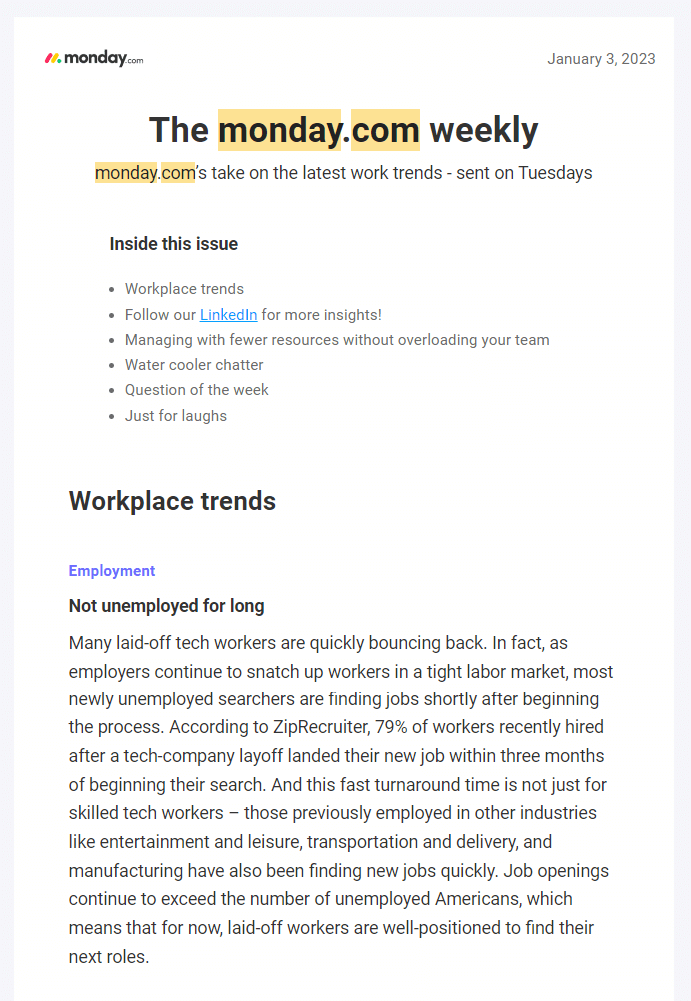
monday.com features a noteworthy knowledge base and hundreds of blog articles on its site. However, when it comes to email marketing, the Unicorn status SaaS brand focuses on building community.
Its journalism style appeals to the everyday CEO, project manager, or planner ready to face their Tuesday with some quick industry insights from their trusted project management tool.
Formal writing style: Calendly
To appeal to professionals, Calendly uses a formal writing style in its product newsletters and announcements.
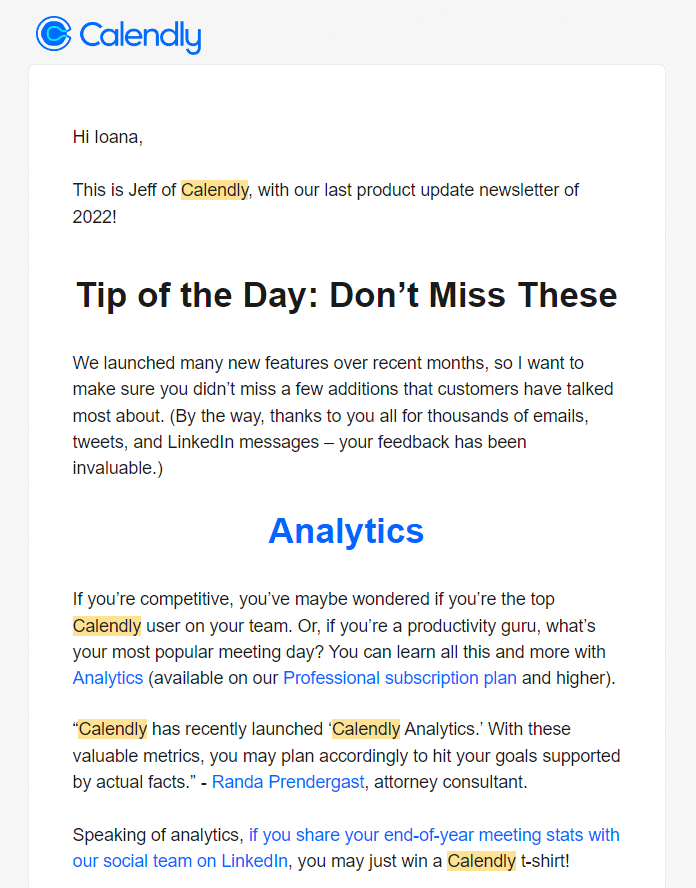
It also features social proof from happy professionals who are currently using the tool and the option to win a prize by engaging with the brand on LinkedIn.
By keeping its newsletter writing style pointed toward its ideal customer, adding user-generated content, and integrating its email marketing with social media marketing, Calendly positions itself as the go-to calendar tool for professionals.
Straightforward writing style: Streak
There’s nothing like getting straight to the point to appease subscribers that are pressed for time — a perfect call for Streak’s target audience, which includes busy sales professionals, outreach specialists, and marketers.
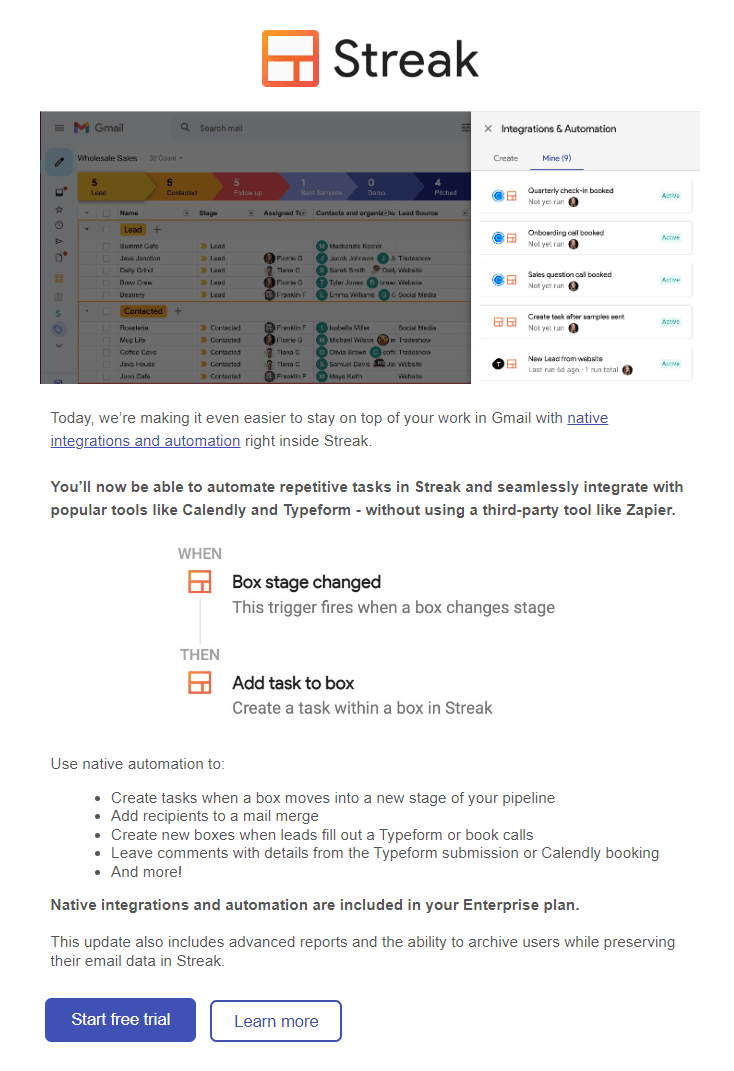
With its ability to track email open rates and pull valuable CRM data, Streak users rely on the tool to get through robust outreach and cold emailing campaigns.
With lists of contacts to pitch to on a regular basis, Streak users need quick tool screenshots and updates. This way, they can improve their outreach workflows without investing too much time.
And with that, we’d say Streak delivers.
Conversational writing style: Copy.ai
With a passion for great copywriting, it’s no surprise Copy.ai chose a conversational writing style for its newsletter subscribers.
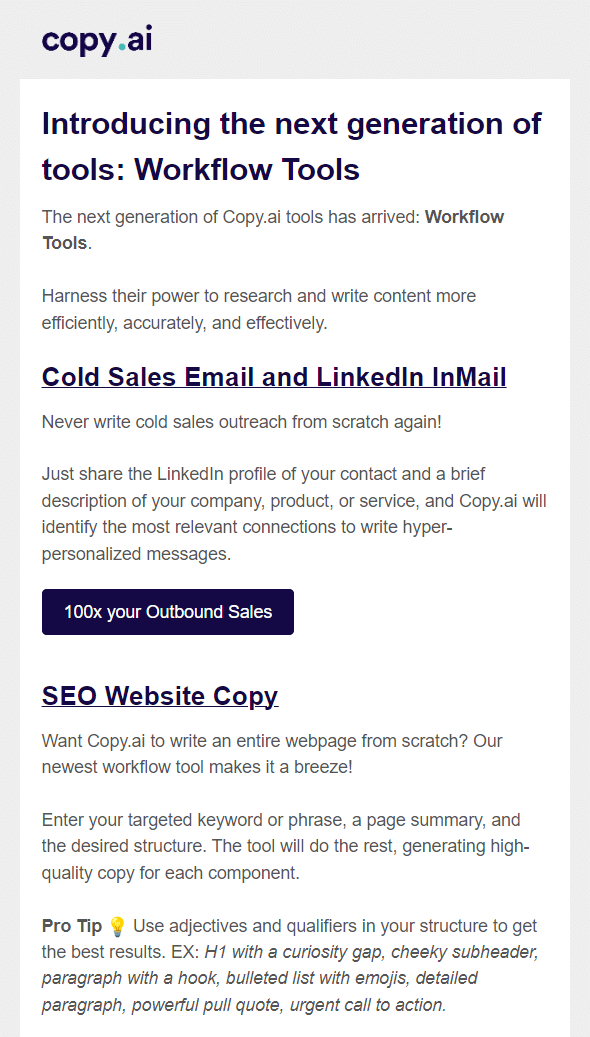
Copy.ai even goes above and beyond by using its own AI tools to write its newsletters (including the one featured above).
With a knack for personalized copy, and its tenacity to change the future of marketing with AI software, Copy.ai presents itself as the go-to copywriting platform for content creators.
Positive, value-driven writing style: Trello
With a passion for inspiring its subscribers to stay organized and collaborative, Trello shares featured articles to help readers develop personally and professionally.
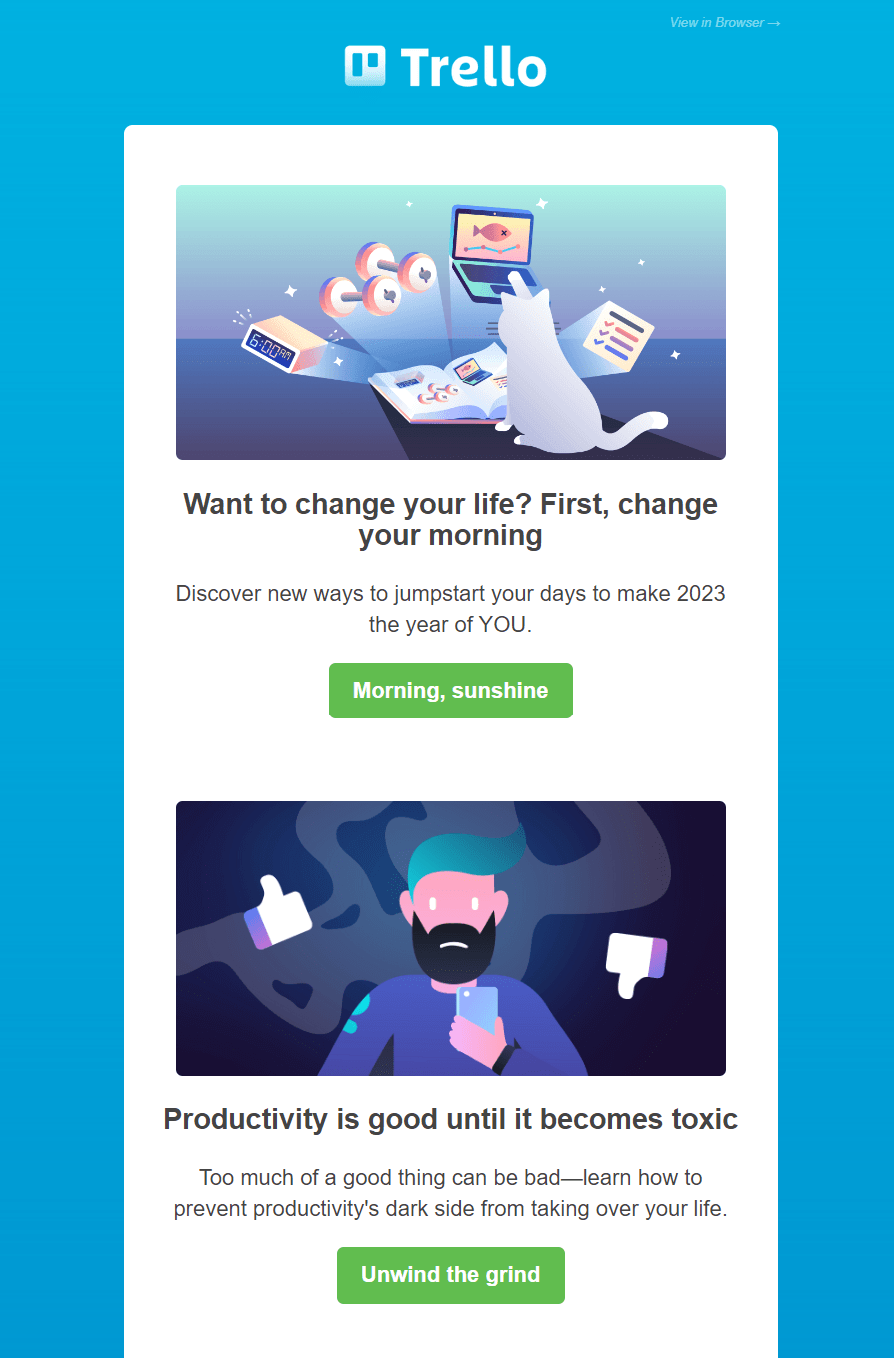
Its desire to see its audience thrive shines through with its tips and advice on wellness, productivity, and forming positive habits — in perfect sync with its brand identity and product offers, too.
Genius, if we do say so ourselves.
Ready to develop your own email writing style?
Remember: there’s no one-size-fits-all writing style.
When it comes to your unique SaaS brand, developing your email writing style requires thoughtful consideration, testing, and careful analysis.
But once you put in the work, all that’s left to do is create a style guide and start planning your email campaigns.
Are you ready to develop a brand and customer-focused email writing style? We hope today’s insights have given you the inspiration you need to get started.
Don’t miss out on new articles. Subscribe to our newsletter and get your monthly dose of SaaS email marketing insights.





